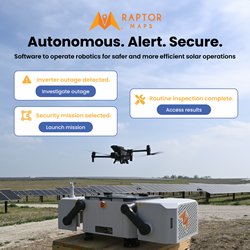U.S. Solar Asset Managers Must Account for Extreme Weather Impacts - Vaisala
Frequency of "nat cat" events in 2016 underlines growing requirement for reliable on-site weather data to inform operational decision-making
Investment in site-specific weather data and measurement equipment is essential for U.S. solar project owners and asset managers, faced with a rising frequency of extreme weather and climate-driven disasters. Furthermore, operators must gather more than just irradiance data to protect their assets from both unexpected performance shortfalls and financial and physical losses.
These observations are supported by 2016 U.S. Solar Performance Maps, released by Vaisala, a global leader in environmental and industrial measurement. The maps illustrate how solar irradiance levels varied from long-term averages in a year when the cost of climate and weather-related damage to infrastructure in the United States exceeded $200 billion.[1]
"2016 saw fifteen 'billion-dollar' extreme weather incidents - one fewer than the all-time record," said Dr. Louise Leahy, Solar Analyst at Vaisala. "As the frequency and severity of these events continues to rise, solar asset managers should take steps to ensure that they are well-placed to mitigate performance and other financial impacts at their sites."
Extreme conditions impact quarterly project performance
The influence of widespread extreme weather patterns is visible in Vaisala's quarter-by-quarter analysis of US solar irradiance. In Q1, a lingering El Niño drove drought conditions - and above average solar resource - in the Southern Plains and Southwest. Simultaneously, above average precipitation across the Northwest, Central Plains, Midwest and along the East Coast may have resulted in subpar project performance for many operators.
In Q2, numerous flooding events, and several intense hailstorms hit Texas, while large wildfires on the West Coast resulted in site shutdowns and performance shortfalls due to smoke cover. Wildfires and flooding continued into Q3, and by the end of September the U.S. had experienced 12 extreme weather incidents, each causing losses exceeding $1 billion - including four major floods and eight severe storms.
Finally, Q4 saw the impact of wetter than average conditions across much of the U.S., causing irradiance levels to fall by up to 10% from the long-term average in many states, including parts of Texas and California.
Covering all of the variables
"Extreme weather poses a dual threat to solar assets - affecting not just the local resource, but also the physical condition of modules and other equipment," added Gwendalyn Bender, Head of Solar Services at Vaisala. "With further incidents expected throughout 2017, we recommend that asset managers cover all of the variables by combining satellite irradiance datasets with thorough on-site data collection and analysis."
Vaisala's long-term, historical solar resource and weather data helps analyze the susceptibility of site and project infrastructure to extreme weather events such as flooding, high winds and hailstorms. For real-time condition monitoring, Vaisala's SP-12 Solar Weather Station, launched this year, includes all of the instrumentation required for analysis of the full range of parameters that affect solar project performance. The Weather Station includes a multi-weather sensor capable of measuring wind speed and direction, ambient temperature, humidity, pressure and rainfall. In turn, this site-specific data can be used to inform critical short-term decisions, such as when to stow panels in the case of hail or high winds, and also provides a means of evaluating impacts to future performance following major weather events that may have damaged project assets.
Click here to access Vaisala's 2016 Solar Performance Maps of the United States.
Vaisala will be in attendance and available to discuss these findings at the Solar Asset Management conference in San Francisco, March 28-29.
Vaisala is an expert in renewable energy resource measurement, project assessment, energy forecasting, and asset management. For more information on the range of services offered by Vaisala to the renewable energy sector, please visit www.vaisala.com/energy.
Featured Product

Raptor Maps - The integrated operating system for end-to-end solar management
Operate autonomous drones and other robotics technology on your solar farms with Raptor Maps' robotics operations platform. Our end-to-end solution allows you to build and schedule data collection missions, to analyze collected data through our analytics engine, and to address identified issues through our remediation intelligence suite. From construction monitoring to substation inspections to SCADA-alert generation missions, Raptor Robotics gives your team unparalleled insights into the health and status of your project. Improve the safety, efficiency, and scale of your operations with Raptor Robotics.
